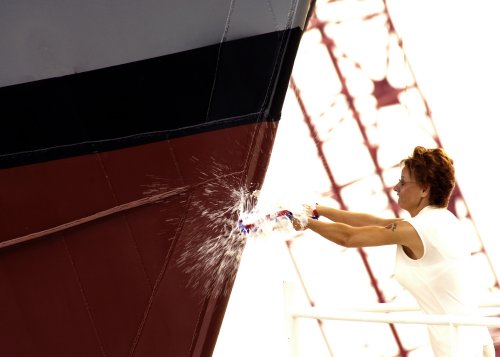How To Break A Bottle.. for good luck

BBC reports on a long standing maritime tradition:
Last year the Duchess of Cornwall failed to smash a bottle on the side of cruise liner Queen Victoria; later scores of passengers were taken ill with a contagious stomach bug.
To avoid this ill omen, the shipping industry has many tricks to ensure the bubbly breaks.
Champagne bottles are extremely tough, having been designed to withstand high pressure, but it only takes a tiny defect, such as a bubble in the glass, to compromise its strength, says Dr Mark Miodownik, a material scientist at King’s College London.
“Glass is a very hard material. If you want to make a defect in it, you’ll find it very difficult, but a diamond is stronger. My top tip would be to score the bottle with a diamond.”
Size matters
Dr Miodownik says that mathematical probability, rope type and bubble size all come into it. The bigger the bottle, the higher the mathematical probability of a natural defect, so he recommends using a jeroboam.
Forget about vintage, it’s bubble size that counts. “The bigger the bubbles, the higher the pressure inside the bottle, the more likely it is to break on impact. The best option is probably to go for a cheap bottle of cava with big bubbles.”
And increase this effect by giving the bottle a good shake.
A rope which has any elasticity in it will absorb the energy, so steer clear, says Dr Miodownik. Better than rope would be a length of wire.
While most ship bows are made of rigid steel, some parts will be even more solid than others – so x-ray the bow, locate the groins (main support structures) and take aim for these. Continue Reading…BBC website.<>p>
History
About.com give us the history:
The ceremony of christening new ships began in the distant past, and we know that Romans, Greeks, and Egyptians all held ceremonies to ask the gods to protect sailors.
By the 1800s the christenings of ships began to follow a familiar pattern. A “christening fluid” would be poured against the bow of the ship, though it was not necessarily wine or champagne. There are accounts in the US Navy records of 19th century warships being christened with water from significant American rivers.
The christening of ships became great public events, with large crowds assembled to witness the ceremony. And it became standard for champagne, as the most elite of wines, to be used for the christening. The tradition developed that a female would do the honors and be named the sponsor of the ship.
And maritime superstition held that a ship that wasn’t properly christened would be considered unlucky. Continue reading…
For a more detailed history of this tradition read: Naval Historical Center’s FAQ
Photo shows Birgit Smith, christened the US Navy’s LCS FREEDOM

Subscribe for Daily Maritime Insights
Sign up for gCaptain’s newsletter and never miss an update
— trusted by our 109,118 members

Get The Industry’s Go-To News
Subscribe to gCaptain Daily and stay informed with the latest global maritime and offshore news

 Join The Club
Join The Club








